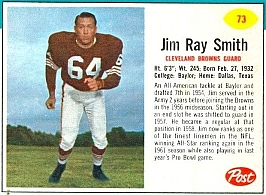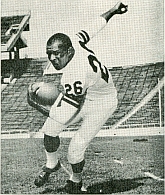Kristin Didn't Do It
Note: There are twelve pages, including this one, that follow detailing the search for the photographers of the 1962 Post cereal football card set. They run in sequential order, top to bottom by using the links from the Photographer menu. You may also click the "Next" link in the lower right corner of each page. The story is a little lengthy but there is a lot of good stuff along the way. If you would rather skip to the end to find out, the next to last link—"Camping Out"—will tell you who shot the photos.
 Since you are interested in Post cereal football cards, the odds are pretty good that you remember the question “Who shot J.R.?” The late 70s through early 80s prime time soap opera “Dallas” ended its 1979-80 season with bad boy J. R. Ewing catching a bullet, leaving viewers to ponder all summer long who it was that wanted him dead. Post cereal football cards have their own J. R. in the person of the player featured on card number 73, Cleveland Browns lineman Jim Ray Smith.
Since you are interested in Post cereal football cards, the odds are pretty good that you remember the question “Who shot J.R.?” The late 70s through early 80s prime time soap opera “Dallas” ended its 1979-80 season with bad boy J. R. Ewing catching a bullet, leaving viewers to ponder all summer long who it was that wanted him dead. Post cereal football cards have their own J. R. in the person of the player featured on card number 73, Cleveland Browns lineman Jim Ray Smith.
Almost twenty years prior to the “Dallas” cliffhanger, beginning in July 1961 fourteen National Football League teams were headed to training camp. The expansion Minnesota Vikings got a special dispensation from NFL Commissioner Pete Rozelle to begin summer drills at Bemidji (Minnesota) State College on July 7th due to their fledgling status. The Dallas Cowboys were also allowed to start on the same day in Northfield, Minnesota at St. Olaf College because of an early preseason game with the Vikes, scheduled for August 5th in Sioux Falls, South Dakota.
The first summer of the Kennedy administration was a time of transition in the United States. The space race with the Russians that began in the late 50s was quickly gathering momentum amid squabbles between the two countries over nuclear testing and refugees fleeing Soviet control in East Germany—the Berlin crisis was well under way. Gus Grissom was rescued in the Atlantic Ocean after a successful sub-orbital space flight only to have the space ship sink when the hatch blew upon opening. Propaganda wars with Cuba were being proposed by members of the U.S. government and an Eastern Airlines plane was hijacked after it left Miami and forced to land in Havana. In the sports world, Ty Cobb died from cancer on July 18th, Cassius Clay scored his eighth consecutive professional victory only a year removed from winning an Olympic gold medal and the NFL champion Philadelphia Eagles battled the College All-Stars at Soldier Field in Chicago in the annual kickoff to the pro season.
Twelve members of the 1961 College All-Star team would make the cut of 200 Post cereal football stars appearing in the 1962 set. The Redskins’ Fred Hageman, Joe Krakoski, Joe Rutgens and Norman Snead represented the most All-Stars from any particular team while Mike Ditka (Bears) and Bob Gaiters (Giants) were the lone representatives from their squads. Jimmy Johnson and Bill Kilmer would join the 49ers in a few weeks. Rip Hawkins and Tommy Mason of the Vikings along with Cowboys Bob Lilly and Glynn Gregory not only were in Chicago for the College All-Star game on August 4th, they somehow found their way to Sioux Falls for the aforementioned exhibition game between the two clubs the very next evening. They were tough men in their new profession where a morning of getting shot by the camera was a welcome respite from grass drills in the middle of summer.
 One of the rookie All-Stars who went on to pro football stardom was Michigan State running back Herb Adderley. Moved to the defensive side of the ball by Packers’ coach Vince Lombardi, Adderley would become what today is known as a “shut down” cornerback on his way to pro football’s Hall of Fame. One would have thought, even in 1961, that Adderley would be a lock for Post to include in their upcoming football cards. But he was not picked.
One of the rookie All-Stars who went on to pro football stardom was Michigan State running back Herb Adderley. Moved to the defensive side of the ball by Packers’ coach Vince Lombardi, Adderley would become what today is known as a “shut down” cornerback on his way to pro football’s Hall of Fame. One would have thought, even in 1961, that Adderley would be a lock for Post to include in their upcoming football cards. But he was not picked.
What happened such that Herb was skipped? How is it that College All-Stars Hawkins, Mason, Lilly and Gregory get shot by the Post photographer, but Adderley totally misses out? Who shot J.R.? It certainly wasn’t Kristin Shepard. But the crew that shot J.R. Smith, John Morrow, Paul Hornung, Tommy Mason, Bob Lilly and all the rest have a great story of their own.

